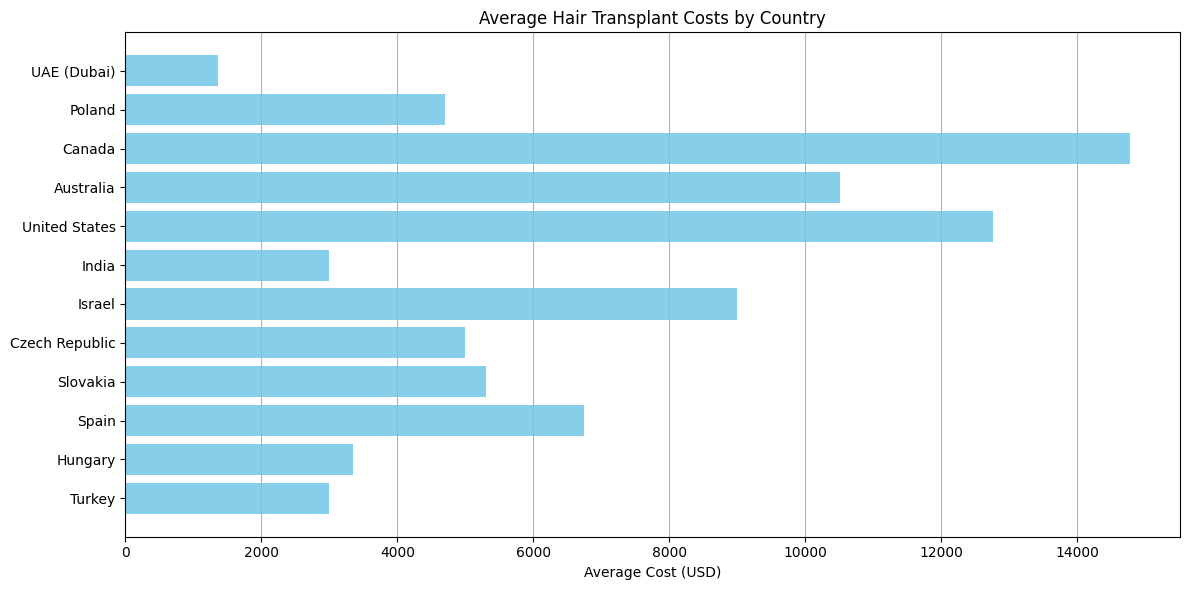Hair Transplant Statistics and Medical Tourism for 2024
Hair loss affects millions of people worldwide, driving demand for hair restoration procedures. As the hair transplant industry continues to grow, medical tourism has become an increasingly popular option for those seeking affordable, high-quality procedures. In this article, we’ll explore the latest hair transplant statistics and the booming trend of medical tourism in this field.
Global Hair Transplant Market Overview
The hair transplant market has experienced rapid growth in recent years, largely due to technological advancements and increasing consumer demand. Here are the latest figures:
- The global hair transplant market was valued at $8.05 billion in 2023 and is expected to reach $16.62 billion by 2032, growing at a compound annual growth rate (CAGR) of 8.80% from 2024 to 2032 [1].
- In 2017, approximately 635,189 hair transplantation procedures were performed worldwide [2].
- The number of hair transplant surgeries has increased by 76% since 2006 [3].
Demographics and Trends in Hair Transplants
Hair transplants aren’t just for men—there’s growing demand across both genders. Here’s a breakdown of the key demographics:
- 85% of men will experience significant hair thinning by the age of 50, making them potential candidates for hair transplants [4].
- 40% of hair transplant patients are women, illustrating that it’s not just a male concern [5].
- The age group of 30-39 years old undergoes the most hair transplant surgeries [6].
- In 95% of hair loss cases, balding is caused by androgenetic alopecia, commonly known as male pattern baldness [7].
Success Rates and Patient Satisfaction
Hair transplants have seen great success over the years, with high patient satisfaction rates. Here are the key figures:
- Hair transplants have a success rate of 97% or higher when performed by qualified surgeons [8].
- About 60% of hair transplant patients report feeling more attractive following their procedure [9].
- The most common reasons for seeking a hair transplant include improving social or dating life (37%) and career enhancement (34.7%) [10].
Medical Tourism for Hair Transplants
Medical tourism for hair transplants is on the rise as patients seek affordable, high-quality care in other countries. Let’s take a look at the top destinations:
Top Destinations for Hair Transplant Tourism
- Turkey: The global leader in hair transplants, Turkey treats around 5,000 international patients each month [11]. Average cost: $2,675 [12].
- India: Known for affordable, high-quality procedures, India’s average cost for a 2,000-graft transplant is $2,781 [13].
- Thailand: A popular destination offering savings of 55-75% compared to U.S. prices [14].
- Mexico: Close proximity to the U.S. and affordable prices make Mexico an attractive option, with an average cost of $3,500 [15].
- Hungary: A rising European destination for hair transplants, Hungary offers procedures at an average cost of €3,100 (approximately $3,350) [16].
Cost Comparison of Hair Transplants by Country
The cost of hair transplant procedures varies significantly between countries. The table below highlights the average costs in several popular destinations:
| Country | Average Cost (USD) |
|---|---|
| USA | $13,610 |
| UK | $10,000 (£8,050) |
| Turkey | $2,675 |
| India | $2,781 |
| Thailand | $1,000 - $2,000 |
| Mexico | $3,500 |
| Hungary | €3,100 (approx. $3,350) |
Factors Driving Medical Tourism for Hair Transplants
Several factors make medical tourism for hair transplants an appealing option for patients:
- Cost savings: Patients can save up to 70-80% by opting for hair transplants abroad, compared to the costs in the U.S. or the UK [17].
- High-quality care: Many top destinations offer state-of-the-art facilities and experienced surgeons, ensuring high-quality results [18].
- Advanced techniques: Countries like Turkey and India specialize in modern hair transplant techniques such as Follicular Unit Extraction (FUE) and Direct Hair Implantation (DHI) [19].
- Combining treatment with a vacation: Many patients combine their hair restoration with a holiday in scenic locations [20].
- Shorter waiting times: Clinics abroad often provide quicker appointments and reduced waiting times for procedures [21].
Popular Hair Transplant Techniques
There are several techniques available for hair transplants, with two leading the field:
- Follicular Unit Extraction (FUE): The most common technique, accounting for about 66% of all procedures [22].
- Direct Hair Implantation (DHI): A newer method that is gaining popularity, particularly in Turkey [23].
Considerations for Medical Tourists
While traveling abroad for a hair transplant offers numerous benefits, patients should carefully consider the following:
- Thorough research: It’s crucial to investigate the clinic's reputation, surgeon qualifications, and patient reviews before committing to a procedure [24].
- Potential risks: Be aware of complications such as infection or scarring and ensure the clinic provides appropriate aftercare [25].
- Plan for recovery: Allow enough time for initial healing before traveling back home, as post-procedure care may require an extended stay [26].
- Language barriers: Consider clinics that offer translation services to ensure clear communication with the medical staff [27].
- Legal protections: Understand the legal recourse available in the destination country in case of malpractice or unsatisfactory results [28].

